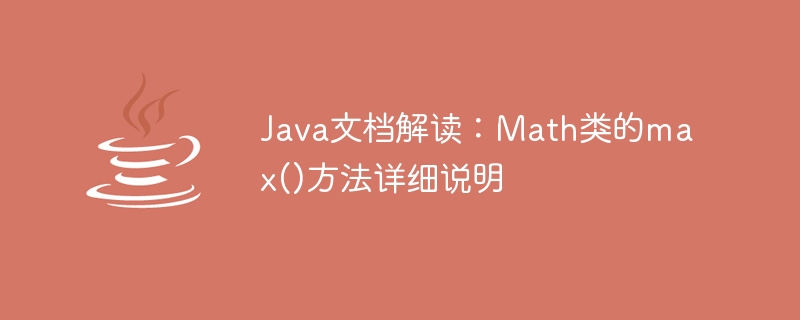

Java is a high-level programming language widely used in various applications. Its rich class library provides developers with a lot of convenience, including the Math class. The Math class is an important class in Java. It provides various mathematical calculation methods, such as calculating absolute values, trigonometric functions, exponentials and logarithms, including the max() method.
The max() method is a very convenient and practical method in the Math class. The function of this method is to take the larger of two numbers. This method is absolutely essential if you want to make numerical comparisons in development. In this article, we will explain the max() method in the Math class in detail and demonstrate its usage through specific code examples.
Syntax:
public static int max(int a, int b);
public static long max(long a, long b);
public static float max(float a, float b);
public static double max(double a, double b);
Parameters:
Parameter a: The first number that needs to be compared.
Parameter b: The second number that needs to be compared.
Return value:
Returns the maximum of the two numbers.
First, let's look at a basic code example:
public class Main { public static void main(String[] args) { int a = 8; int b = 19; System.out.println(Math.max(a, b)); } }
In this example, we define two numbers a and b for comparison. We then call the Math.max() method to compare the two numbers and print the return value.
Run this program and the output result is 19, which is the maximum value returned by the method.
In addition to comparing integer numbers, the max() method can also compare other types of numbers, such as long integers, floating point types, and double precision floating point types. Let's look at another code example:
public class Main { public static void main(String[] args) { long a = 1488223200L; long b = 1617309600L; System.out.println(Math.max(a, b)); } }
In this example, we compare two long integer numbers. Note that you need to add an "L" suffix to the number here to indicate that it is a long integer number.
Run this program, the output result is 1617309600, which is the maximum value returned by the method.
Similarly, we can also compare floating-point and double-precision floating-point numbers. Here are two more code examples:
public class Main { public static void main(String[] args) { float a = 8.382f; float b = 9.41f; System.out.println(Math.max(a, b)); } }
In this example, we compare two floating point numbers.
Run this program and the output result is 9.41, which is the maximum value returned by the method.
The following is a code example that compares double-precision floating-point numbers:
public class Main { public static void main(String[] args) { double a = 123456.789; double b = 987654.321; System.out.println(Math.max(a, b)); } }
In this example, we compare two double-precision floating-point numbers.
Run this program and the output result is 987654.321, which is the maximum value returned by the method.
To summarize, the max() method in the Math class is very practical and suitable for various types of numerical comparisons. In daily programming, we often need to compare the size of numbers, so being familiar with the use of the max() method will greatly improve our development efficiency.
The above is the detailed content of Interpretation of Java documentation: Detailed description of the max() method of the Math class. For more information, please follow other related articles on the PHP Chinese website!
 How the tcp three-way handshake works
How the tcp three-way handshake works PHP Tutorial
PHP Tutorial Where should I fill in my place of birth: province, city or county?
Where should I fill in my place of birth: province, city or county? Google earth cannot connect to the server solution
Google earth cannot connect to the server solution What to do if phpmyadmin fails to import sql file
What to do if phpmyadmin fails to import sql file How to register a business email
How to register a business email ntuser.dat deleted recovery method
ntuser.dat deleted recovery method How to configure jdk environment variables
How to configure jdk environment variables



